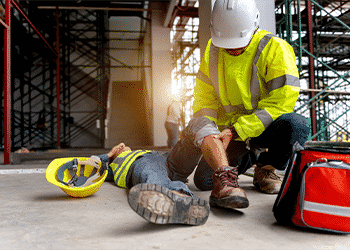Staying compliant with health and safety regulations is a necessity for any business, not just because of the risk of receiving costly fines, but also to avoid potentially serious health and safety hazards.
However, compliance doesn’t need to be complicated. Here are five easy steps to follow to make sure you are setting your safety program, and entire organization, up for success from an employee safety standpoint and from a legal standpoint as well.
Establish safety policies and procedures
This probably feels like it should go without saying, but any solid safety program must start with creating complete policies and procedures for your workplace. If something is important to the success of your business and the safety of your workers, it should be documented. These policies and procedures do not have to be sophisticated or complicated — they just need to be accurate for your needs.
As you’re crafting your safety policies and procedures, consider getting input from all levels of your company. Also, keep in mind that you’re creating a living document that must be maintained regularly. As things change, you should update your documents. Any policies and procedures that remain static will inevitably become outdated and irrelevant.
Looking for more online safety training courses?
Invest in employee training

When solid safety training is implemented, you can be sure your employees are aware of the correct steps to take to create a safe working environment. While you need to be aware of workplace-specific hazards, there are many general safety topics employees should be trained on. For example, in 2020, slips, trips and falls accounted for nearly 17% of workplace fatalities, but this type of accident can often be easily avoided by offering a fall safety course.
One important factor to keep in mind is that over the last five years alone, Hispanic and Latino workers have seen the highest-increasing rate of workplace fatalities, rising from 16% of all workplace fatalities in 2016 to more than 22% of such deaths in 2020. In many cases, employees with limited English-language skills cannot fully understand given safety training, or cannot easily convey their difficulties. Every employee has the right to work safely. You must be sure you are providing information and training for your employees in a format — and language — they understand.
Continue employee awareness
Training is crucial, but it is also important that you make it easy for employees to keep safety top of mind at all times. OSHA provides numerous types of free downloadable or purchasable safety content that can be hung up or placed around your worksite, from quick fact sheets to larger posters and even multi-page booklets. Whether you want to inform workers of proper handwashing technique or post specific safety regulations, keeping safety reminders around at all times helps instill a safety culture.
An oft-overlooked part of employee awareness includes worksite first aid measures. Every employee should know where first aid kits are kept at any location, from an office to a remote construction site. They should also be aware of site-related first aid measures that may need to be taken and pertinent information to inform superiors. Additionally, multiple employees should be trained on any specialized equipment you may have, such as an AED machine.
Encourage open communication

Most companies like to believe they have an effective communication system in place, and they very well may be good at disseminating information throughout their organization. But when information only goes in one direction, can you really consider that communication? At that point, all you are doing is telling.
Of course top-down communication makes sense when it comes to relaying employee training and continued safety awareness, but those in management positions should also listen to their employees. Two-way communication is especially important when it comes to safety because, after all, those workers below management level are the ones doing the jobs you are wanting to train over. They know the work the best, and can help a safe and effective worksite.
Conduct audits and inspections
You can have all the best training and safety systems in the world, but without testing those systems and processes, you’ll never know if what you’re doing is working. Compliance audits and safety inspections allow you to not only make sure employees are taking the correct measures, but also ensure that your systems are still effective.
Many times, employees feel like process audits are set up almost as a trap to catch them doing something incorrectly, whether they actually are or not. However, audits should never introduce this kind of pressure. During every audit, whether announced or unannounced, make sure all employees know they aren’t being tricked. Instead, use this time to confirm your processes are strongly in place, or, if employees are working a different way, understand why. Maybe the different — but “incorrect” — way is actually what you should be doing.

An Online Training Partner Can Help
Whether you are needing to start getting serious about your safety compliance or are just looking at ways to expand and improve your organization’s ability to manage your safety program, choosing an experienced online partner can help in many ways.
Conduct a job hazard analysis
OSHA makes it clear that employers are required to “provide a workplace free from serious recognized hazards” for all employees. Therefore, it is vital you understand what these potential hazards are in your workplace. Depending on your industry and your specific jobsite, there could be any number of different hazards present, including electrical equipment, dangerous goods or heavy machinery.
Conducting a job hazard analysis (JHA) will help you understand the most hazardous jobs in your workplace, what those specific hazards entail, and corrective and preventive measures you can take to reduce or completely eliminate the likelihood of accidents, injuries and illnesses. The right online partner makes it easy to conduct these crucial assessments so you can focus on safely moving forward.
Have proper incident documentation
While so much of the occupational health and safety industry is about being proactive and recognizing — and then hopefully eliminating — hazards before they can even become an issue, accidents do still happen. And when they do, everyone needs to be prepared. This means understanding what needs to be reported, how, and to whom. Complete and accurate reporting ensures the incident is resolved properly. It also helps to show where additional training or safety precautions may be needed.
Unfortunately, not all companies have clear and consistent incident management procedures. There are certain steps that must be taken and all employees should receive training in this area. Having correct and complete incident forms available for any employee to fill out means no matter who was involved, you can trust that you will have proper documentation for your own review as well as for official submission.
Be aware of the modern learner

Traditionally, safety programs were an in-person, classroom function. Employees would spend one or many days in safety training, documentation was kept in folders in the office and safety records were always in physical form. These days, with nearly 90% of Americans owning smartphones and more employees than ever finding themselves doing remote work, safety programs have adapted and must continue doing so.
Taking your training online allows for increased access for all employees, makes managing the full safety program easier for members of a safety department or HR and allows for quicker and more effective adjustments as organizational needs — or governing regulations — change.
Stay on top of OSHA reporting
Since enforcement is part of OSHA’s mission, they regularly conduct workplace inspections, often following a worker complaint, and during these reviews they may request to see various records of injuries and illnesses. Because OSHA inspections can result in potentially serious fines, it is wise for all employers to make sure their recordkeeping is thorough and accurate, and aligns with what OSHA would expect to see.
Ensuring you are doing everything fully by the book and up to OSHA standards can seem daunting, but it doesn’t have to be. Working with an expert in safety training can help you get up to speed and make sure your records are prepared for an inspection or for OSHA submission.
Let SafetySkills Help You Simplify Compliance
While it should go without saying, training serves as the foundation for helping your entire workforce minimize safety risks, making your organization less likely to fall out of compliance and your workers less likely to have an on-the-job incident that needs to be recorded.
Taking online safety training is convenient as each of your employees can receive training on a wide range of topics, from the uses of various PPE to understanding industry- or job-specific OSHA regulations..
Another benefit to taking training online is how easy it is to repeat training as often as is needed — or as often as you’d like. Some OSHA regulations require training to be conducted at least annually.
It’s never a wrong time to evaluate your current safety program, or implement a new one, to protect your employees and ensure you are adhering to OSHA standards. Contact SafetySkills today to see how we can help you get a head start on improving your safety program and keeping you in compliance.


